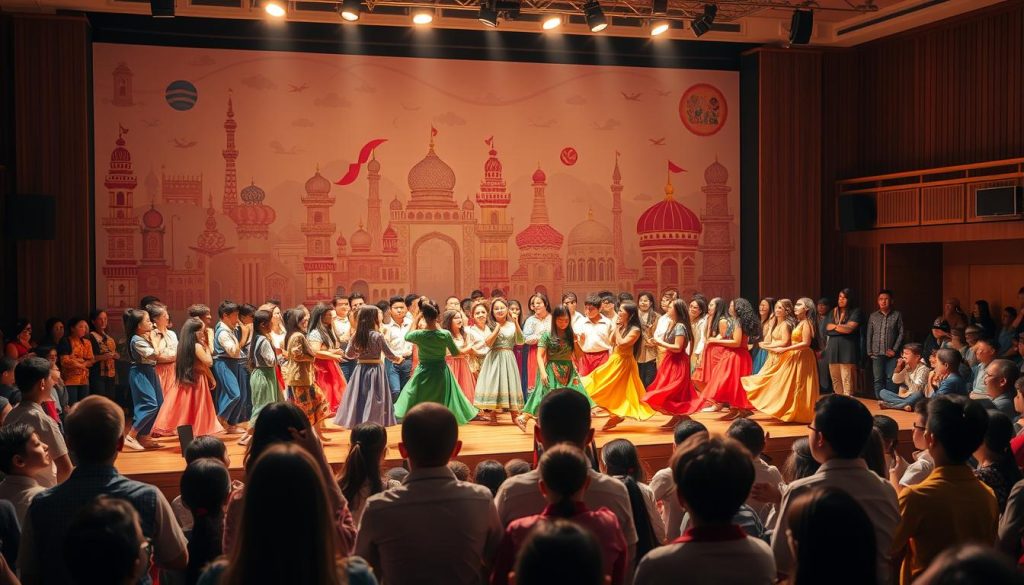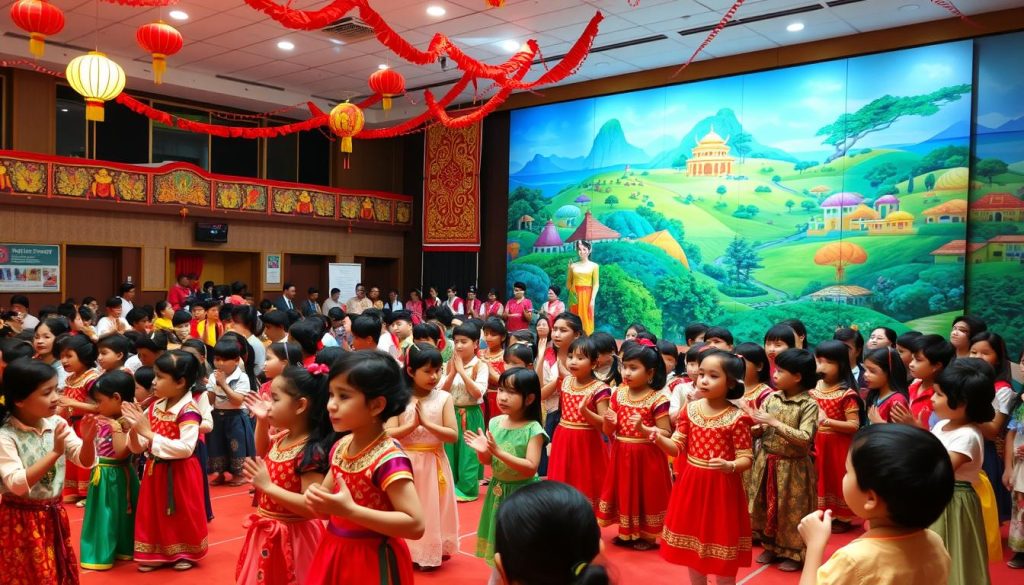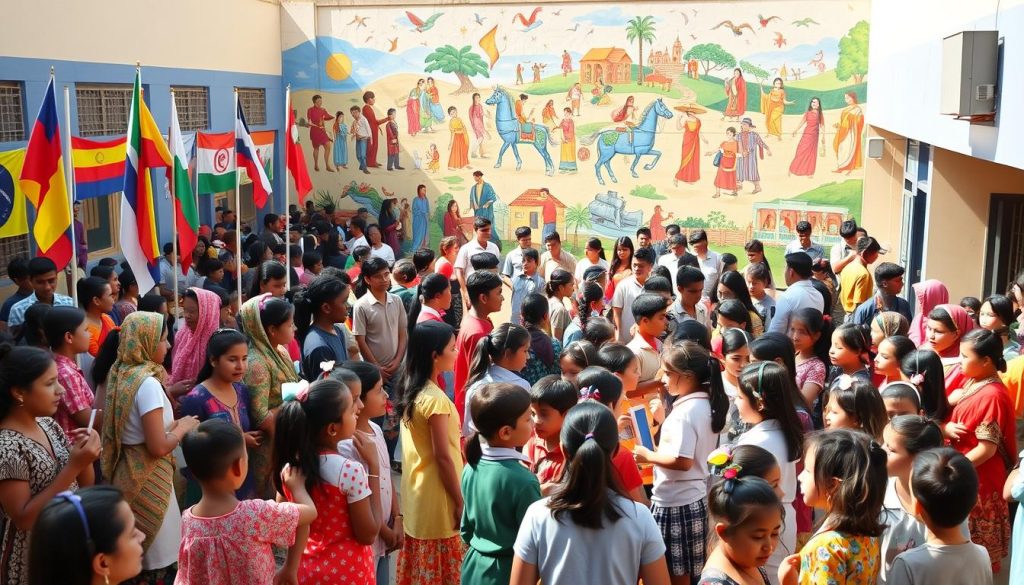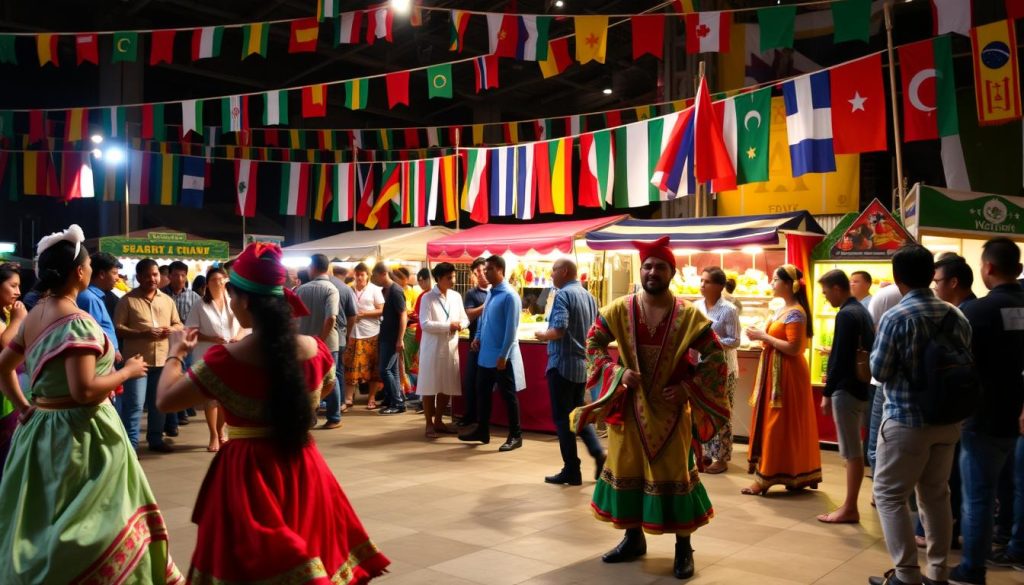Embracing diverse cultural festivals and international days at school can be a transformative experience for students, fostering a sense of global citizenship and cultural awareness.
By incorporating various cultural celebrations into school life, students can gain a deeper understanding of different cultures and traditions, promoting inclusivity and diversity.
This enriching experience not only benefits students but also enhances the overall school community, creating a more harmonious and respectful environment.
Key Takeaways
- Promotes global citizenship and cultural awareness
- Fosters inclusivity and diversity
- Enhances the overall school community
- Provides a unique learning experience for students
- Encourages cultural exchange and understanding
The Value of Multicultural Education in Today’s Schools
As the world becomes more interconnected, the value of multicultural education in schools is rising. Multicultural education is not just about teaching different cultures; it’s about fostering a deeper understanding and appreciation of the diverse backgrounds that make up our global community.
Building Cultural Awareness and Appreciation
Multicultural education helps students develop cultural awareness by exposing them to various traditions, customs, and practices from around the world. This awareness is crucial in today’s diverse classrooms, where students from different backgrounds come together. By incorporating celebrations around the world into the curriculum, schools can create an inclusive environment that values diversity.
Creating Opportunities for Authentic Learning
Authentic learning experiences are vital for engaging students and making education more meaningful. School assemblies and concerts that celebrate different cultural festivals provide a unique opportunity for students to learn about and experience various cultures firsthand. These events can range from traditional dance performances to cultural fairs, offering a rich tapestry of experiences that enhance the educational journey.
Developing Empathy Through Cultural Understanding
One of the most significant benefits of multicultural education is the development of empathy among students. By learning about different cultures and their practices, students can gain a deeper understanding of the challenges and triumphs faced by people from diverse backgrounds. This empathy is fostered through interactive and immersive experiences that encourage students to walk in others’ shoes.
| Benefits of Multicultural Education | Description | Examples |
|---|---|---|
| Cultural Awareness | Understanding diverse cultures and traditions | Celebrating Lunar New Year, Diwali |
| Authentic Learning | Experiential learning through cultural events | School assemblies, cultural concerts |
| Empathy Development | Fostering understanding and empathy among students | Interactive cultural workshops |
Benefits of Cultural Festivals and International Days for Students
Participating in global events and performances can significantly enhance a student’s educational experience. Cultural festivals and international days provide a platform for students to engage with diverse cultures, fostering a deeper understanding and appreciation of the global community.
Developing Global Citizenship Skills
Cultural festivals and international days help students develop essential global citizenship skills. By learning about different cultures and traditions, students become more empathetic and open-minded, preparing them to thrive in an increasingly interconnected world. These events encourage students to think critically about global issues and develop a sense of responsibility towards their global community.
Enhancing Social and Emotional Learning
These celebrations also play a significant role in enhancing students’ social and emotional learning. By participating in cultural events, students improve their communication skills, build confidence, and develop a stronger sense of identity. The collaborative nature of these events promotes teamwork and mutual respect among students from diverse backgrounds.
Connecting Academic Content to Real-World Contexts
Cultural festivals and international days provide opportunities to connect academic content to real-world contexts, making learning more relevant and engaging. By integrating cultural studies into the curriculum, educators can create a more holistic learning experience that prepares students for the complexities of the modern world.
Improving Student Engagement Through Cultural Relevance
When students see their cultural heritage reflected in the curriculum, they are more likely to be engaged and motivated. Cultural festivals and international days make learning culturally relevant, thereby improving student engagement and academic performance. This approach helps in creating a more inclusive educational environment where all students feel valued.
Planning Effective School Assemblies for Cultural Celebrations
To make the most of cultural celebrations in schools, it’s essential to plan carefully and consider the diverse backgrounds of students. Effective planning ensures that these events are both educational programs and enjoyable experiences for all participants.
Creating a Yearly Calendar of Cultural Events
Developing a yearly calendar of cultural events is a crucial first step in planning school assemblies. This involves identifying significant cultural festivals and international days to be celebrated throughout the year. By doing so, schools can create a cohesive and comprehensive educational program that promotes cultural awareness.
Forming a Diverse Planning Committee
A diverse planning committee is vital for organizing culturally sensitive and inclusive assemblies. This committee should comprise teachers, parents, and students from various cultural backgrounds. Their collective input helps ensure that the assemblies are respectful and representative of the school’s diverse community.
Involving Students in the Planning Process
Involving students in the planning process not only enhances their engagement but also provides them with valuable learning experiences. Students can contribute to research, presentations, and performances, making the assemblies more meaningful and interactive showcases of their talents and knowledge.
Checklist for Culturally Respectful Assemblies
- Research the cultural significance of the event being celebrated.
- Involve representatives from the relevant cultural community in the planning process.
- Ensure that all materials and performances are accurate and respectful.
- Avoid stereotypes and cultural appropriation.
- Provide opportunities for student participation and feedback.
By following these steps and checklist, schools can create educational programs and showcases that celebrate cultural diversity and promote a more inclusive and respectful school environment.
Organizing Engaging Cultural Concerts at School

Organizing cultural concerts is an effective method to promote diversity and inclusion in educational settings. These events not only celebrate international festivities and gatherings but also provide a platform for students to showcase their cultural heritage.
Showcasing Traditional Music and Dance
A key element of cultural concerts is the inclusion of traditional music and dance from various cultures. This can be achieved by inviting guest performers or by having students perform themselves. For instance, a school might feature a traditional African drumming performance, a classical Indian dance, or a Mexican mariachi band.
Collaborating with Local Cultural Organizations
To add authenticity and depth to the cultural concerts, schools can collaborate with local cultural organizations. These organizations can provide resources, performers, or instructors who can help students learn about different cultures. For example, a local Japanese cultural center might provide a taiko drumming performance or instruction.
Technical Considerations for School Performances
When organizing cultural concerts, technical considerations are crucial. This includes ensuring adequate sound and lighting equipment, as well as a suitable performance venue. Schools should also consider the logistics of staging, costumes, and props.
Preparing Students for Performance Success
To ensure students are well-prepared for the cultural concert, schools should provide rehearsal time and guidance on performance etiquette. This not only enhances their performance skills but also boosts their confidence. Here are some key aspects to focus on:
| Aspect | Description | Benefits |
|---|---|---|
| Rehearsal Time | Adequate time for students to practice their performances. | Improved performance quality, reduced stage fright. |
| Performance Etiquette | Guidance on stage behavior, audience interaction, and cultural sensitivity. | Enhanced professionalism, respect for cultural traditions. |
| Costumes and Props | Authentic attire and items that represent the culture being showcased. | Adds visual appeal, enhances cultural authenticity. |
By focusing on these aspects, schools can host engaging cultural concerts that celebrate international festivities and gatherings, promoting a richer understanding and appreciation of diverse cultures among students.
Cultural Festivals and International Days – School Assemblies and Concerts
Integrating cultural festivals and international days into school assemblies and concerts can significantly enhance student learning. By doing so, schools can create an engaging and inclusive environment that promotes cultural awareness and appreciation.
Matching Celebrations to Educational Objectives
To maximize the educational value of cultural festivals and international days, it’s crucial to align these events with the school’s curriculum and educational objectives. This can be achieved by incorporating relevant cultural studies into the school’s academic content, thus providing students with a more holistic learning experience.
For instance, when celebrating a cultural festival, the school can integrate related historical, literary, or artistic aspects into the curriculum, making the event more meaningful and educational.
Structuring Meaningful Cultural Experiences
Effective planning is key to structuring meaningful cultural experiences. Schools should form a diverse planning committee that includes teachers, students, and parents to ensure a wide range of perspectives and ideas. This committee can help in organizing various activities, such as traditional music and dance performances, cultural exhibitions, and food festivals, that cater to different aspects of the cultural celebration.
Balancing Entertainment with Educational Content
While entertainment is a significant aspect of school assemblies and concerts, it’s equally important to balance it with educational content. This can be achieved by including informative presentations, cultural displays, and interactive activities that complement the entertainment elements.
Sample Program Formats for Different Age Groups
Different age groups have varying attention spans and learning capabilities. Therefore, it’s essential to tailor the program formats according to the age group of the students. For younger students, interactive and visually engaging activities work best, while older students can participate in more complex cultural presentations and discussions.
- For elementary school students: Interactive cultural games, simple traditional dances, and storytelling sessions.
- For middle school students: Cultural presentations, traditional music performances, and food festivals.
- For high school students: In-depth cultural discussions, complex traditional dances, and cultural debates.
By structuring school assemblies and concerts in this manner, schools can ensure that cultural festivals and international days are both enjoyable and educational for students of all ages.
Popular Cultural Festivals to Celebrate Throughout the School Year

Cultural festivals offer a unique opportunity for schools to promote diversity and global awareness. By incorporating various cultural celebrations into the school calendar, educators can create a more inclusive and engaging learning environment.
Lunar New Year, Diwali, and Harvest Festivals
Celebrating festivals like Lunar New Year and Diwali can provide students with insights into different cultural traditions. For instance, Lunar New Year, typically celebrated over 15 days, is a time for renewal and family reunions in many East Asian cultures. Diwali, the Festival of Lights, is a significant celebration in Hinduism, symbolizing the triumph of light over darkness.
Harvest festivals, such as Thanksgiving in the United States or the Mid-Autumn Festival in many Asian countries, are also excellent opportunities for cultural exchange. These festivals often involve traditional foods, decorations, and community gatherings.
Winter Holiday Traditions from Around the World
Winter is a season of diverse holiday traditions worldwide. Schools can celebrate this diversity by exploring various cultural practices, such as Christmas traditions in Europe, Hanukkah in Jewish communities, or Kwanzaa in African-American communities.
Celebrating Cinco de Mayo, Holi, and Other Spring Festivals
Spring brings a variety of vibrant festivals, including Cinco de Mayo, which commemorates Mexican heritage, and Holi, the Hindu festival of colors. These celebrations can be integrated into school assemblies and activities to promote cultural understanding.
Age-Appropriate Activities for Each Festival
For each festival, it’s essential to plan age-appropriate activities. For younger students, simple crafts and storytelling can be engaging. Older students can participate in more complex projects, such as researching and presenting about the cultural significance of the festivals.
| Festival | Age Group | Activity |
|---|---|---|
| Lunar New Year | Primary | Red envelope making, Lion dance performance |
| Diwali | Secondary | Diwali lantern making, Cultural presentation |
| Cinco de Mayo | All ages | Mexican cuisine tasting, Traditional dance |
By incorporating these cultural festivals into the school year, educators can foster a more inclusive and culturally aware environment, enhancing students’ global understanding and appreciation.
Recognizing Important International Days in the Classroom
Celebrating important international days is a valuable way to broaden students’ perspectives on global issues. By incorporating these observances into the curriculum, educators can create engaging learning experiences that foster global awareness and cultural appreciation.
United Nations Observance Days
The United Nations designates several international days that are relevant to educational settings, such as World Peace Day and Human Rights Day. These observances offer opportunities for meaningful discussions and activities that promote peace, equality, and human rights.
- World Peace Day encourages students to reflect on the importance of peace and conflict resolution.
- Human Rights Day provides a platform to educate students about their rights and responsibilities.
Heritage and History Months
Heritage and history months, such as Black History Month and Asian American Heritage Month, are crucial for highlighting the contributions and experiences of diverse communities. These observances help students understand the rich cultural tapestry of society.
“Education is the most powerful weapon which you can use to change the world.” – Nelson Mandela
Global Awareness Campaigns
Global awareness campaigns like Earth Day and World Water Day focus on critical environmental issues. These campaigns can be integrated into the curriculum to educate students about sustainability and conservation.
Developing mini-lesson plans can help teachers effectively incorporate international days into their teaching. For example, on World Peace Day, students can participate in peace-themed art projects or discussions on conflict resolution strategies.
- Create a peace garden or art project that symbolizes peace.
- Host a class discussion on the significance of peace and how it can be achieved.
By recognizing and celebrating international days, schools can enhance students’ understanding of global issues and foster a more inclusive and culturally aware community.
Incorporating Cultural Learning Across the Curriculum
Schools can foster global awareness by integrating cultural studies into their curricula. This approach not only enriches students’ understanding of different cultures but also prepares them for an increasingly interconnected world.
Integrating Cultural Studies in Core Subjects
Integrating cultural studies into core subjects like history, literature, and geography can provide students with a more nuanced understanding of global celebrations around the world. For instance, teaching about various cultural festivals can be seamlessly integrated into history lessons, while literature classes can explore works from diverse cultural backgrounds.
Using Arts and Music to Explore Cultural Traditions
Arts and music offer a vibrant window into cultural traditions. By incorporating global events and performances into the curriculum, educators can help students appreciate the richness of different cultures. This can include studying traditional dances, musical instruments, or art forms from around the world.
Creating Cross-Disciplinary Cultural Projects
Cross-disciplinary projects that combine multiple subjects can offer a comprehensive cultural learning experience. For example, a project on a specific cultural festival could involve research (history), writing (language arts), and presentation (public speaking), culminating in a cultural performance or exhibition.
Assessment Strategies for Cultural Learning
Assessing cultural learning requires a multifaceted approach. Educators can use a variety of methods, including project-based assessments, reflective journals, and presentations, to evaluate students’ understanding and appreciation of different cultures.
Engaging Parents and Community in School Cultural Events
By engaging parents and the community in cultural events, schools can foster a more inclusive and supportive learning environment. This collaborative approach not only enriches the educational experience but also strengthens the bond between the school and its community.
Inviting Family Participation and Contributions
One effective way to engage parents is by inviting them to participate in or contribute to cultural events. This can include sharing their cultural traditions, helping with event planning, or even performing at the events. Parent involvement can add authenticity and depth to the celebrations.
Building Partnerships with Cultural Community Groups
Forming partnerships with local cultural organizations can significantly enhance the quality and authenticity of school cultural events. These partnerships can provide access to resources, expertise, and diverse perspectives, enriching the educational programs and showcases.
Showcasing Student Learning to the Wider Community
Cultural events offer an excellent opportunity to showcase student learning and achievements to parents and the broader community. This not only promotes the school’s educational programs but also highlights the importance of cultural education.
Communication Templates for Family Outreach
To effectively engage parents, schools can use pre-designed communication templates for outreach. These templates can be used for invitations, event updates, or requests for participation, ensuring clear and consistent communication.
As “The more you engage with the community, the more you realize that education is not just about academics; it’s about cultural understanding and exchange.” Engaging parents and the community in school cultural events is a step towards creating a holistic educational experience.
Addressing Challenges in Multicultural Celebrations

As schools strive to create inclusive environments, they must navigate the complexities of multicultural celebrations. Multicultural events are a valuable part of the educational experience, fostering diversity, understanding, and global awareness among students.
Ensuring Authentic Representation
One of the primary challenges is ensuring that multicultural celebrations are authentic and respectful representations of the cultures they honor. This involves careful planning and research to avoid cultural appropriation and stereotypes. Schools can achieve this by involving members of the represented cultures in the planning process, thereby ensuring that events are both accurate and meaningful.
Navigating Religious vs. Cultural Observances
Another challenge lies in distinguishing between religious and cultural observances, ensuring that school events remain inclusive and respectful of all beliefs. Schools must be sensitive to the diverse backgrounds of their students, balancing the celebration of cultural traditions with the need to respect religious practices.
Creating Inclusive Events for All Students
Creating events that are inclusive for all students is crucial. This involves considering the diverse needs and backgrounds of the student body when planning multicultural celebrations. By doing so, schools can foster a sense of belonging among all students.
Responding to Concerns with Cultural Sensitivity
When concerns arise, schools should respond with cultural sensitivity, engaging in open dialogue with students, parents, and staff. This approach helps to address issues thoughtfully and maintain an inclusive environment.
By addressing these challenges with care and sensitivity, schools can ensure that multicultural celebrations enrich the educational experience for all students, promoting a culture of understanding and respect.
Digital Resources and Technology for Cultural Celebrations
Digital innovations offer a wide range of possibilities for enhancing cultural education and celebrations in schools. By leveraging technology, educators can create immersive and engaging experiences that foster global awareness and appreciation among students.
Virtual Cultural Exchange Programs
Virtual cultural exchange programs allow students to connect with peers from different cultural backgrounds worldwide. These programs facilitate the sharing of traditions, customs, and daily life experiences, promoting cross-cultural understanding and empathy. Platforms like ePals and iEARN enable schools to partner with other educational institutions globally, creating opportunities for collaborative projects and cultural exchanges.
Digital Tools for Creating Cultural Presentations
Digital tools can significantly enhance the way students present their cultural projects. Multimedia presentations using tools like Powtoon or Prezi can make cultural stories more engaging and interactive. Additionally, students can create digital posters or infographics using Canva, highlighting key aspects of different cultural festivals and traditions.
Online Resources for Authentic Cultural Information
Access to authentic cultural information is crucial for accurate and respectful representations. Websites like National Geographic’s Culture and UNESCO’s Intangible Cultural Heritage provide rich resources on various cultural practices and traditions. These online resources help students and educators alike to deepen their understanding of global cultures.
Recommended Apps and Websites for Cultural Learning
Several apps and websites are particularly useful for cultural learning, including:
- Duolingo for language learning
- Google Arts & Culture for exploring cultural heritage
- Cultural Vistas for virtual exchange programs
These digital resources not only enhance cultural education but also make learning more engaging and accessible.
Conclusion: Fostering a Legacy of Global Understanding
Celebrating cultural festivals and international days at school is a powerful way to foster global understanding among students. By embracing celebrations around the world, schools can create a rich and inclusive environment that values diversity and promotes cultural awareness.
Through multicultural education and celebrations, students develop essential skills, such as global citizenship, social-emotional learning, and cross-cultural understanding. These experiences not only enrich their academic journey but also prepare them to thrive in an increasingly interconnected world.
By incorporating cultural learning across the curriculum and engaging parents and the community, schools can create a lasting impact on their students’ lives. As educators, we have the opportunity to shape the next generation of global citizens, and celebrating cultural festivals and international days is a vital part of this mission.
FAQ
What are the benefits of celebrating cultural festivals and international days at school?
Celebrating cultural festivals and international days at school fosters a sense of global citizenship, cultural awareness, and appreciation among students, enhancing their social and emotional learning, and connecting academic content to real-world contexts.
How can schools plan effective cultural celebrations and assemblies?
Schools can plan effective cultural celebrations by creating a yearly calendar of cultural events, forming a diverse planning committee, involving students in the planning process, and ensuring culturally respectful assemblies.
What are some popular cultural festivals that can be celebrated throughout the school year?
Some popular cultural festivals that can be celebrated include Lunar New Year, Diwali, harvest festivals, Cinco de Mayo, and Holi, among others, with age-appropriate activities tailored to each festival.
How can teachers incorporate international days into their classroom curriculum?
Teachers can incorporate international days into their curriculum by observing United Nations observance days, heritage months, and global awareness campaigns, using mini-lesson plans to integrate these observances into their teaching.
What are some strategies for engaging parents and the community in school cultural events?
Strategies for engaging parents and the community include inviting family participation, building partnerships with cultural community groups, showcasing student learning, and using effective communication templates for family outreach.
How can schools address challenges that arise during multicultural celebrations?
Schools can address challenges by ensuring authentic representation, navigating religious vs. cultural observances, creating inclusive events, and responding to concerns with cultural sensitivity.
What digital resources are available to support cultural celebrations and learning?
Digital resources include virtual cultural exchange programs, digital tools for creating cultural presentations, online resources for authentic cultural information, and recommended apps and websites for cultural learning.
How can cultural learning be incorporated across the curriculum?
Cultural learning can be incorporated by integrating cultural studies into core subjects, using arts and music to explore cultural traditions, creating cross-disciplinary cultural projects, and using appropriate assessment strategies.




